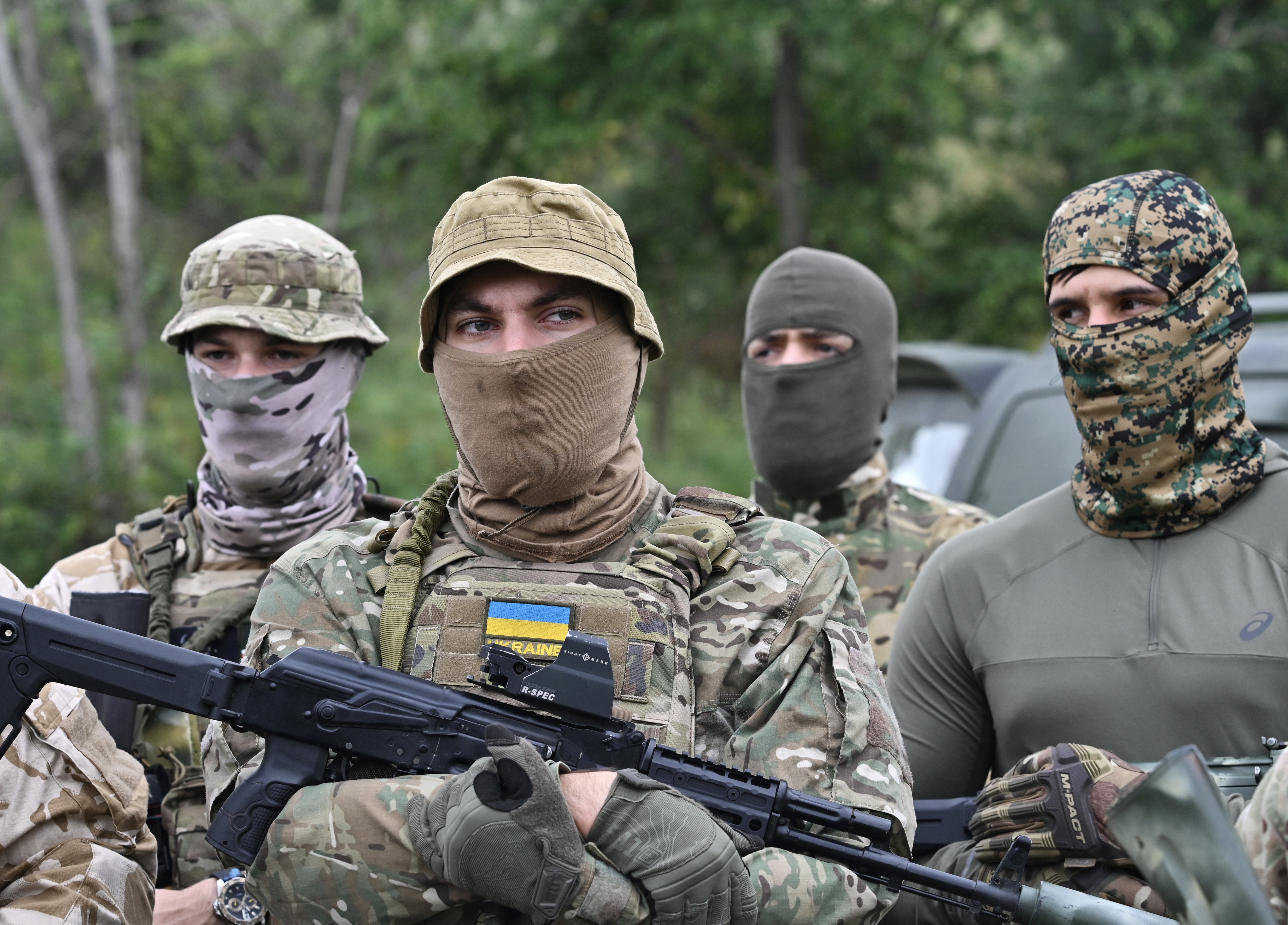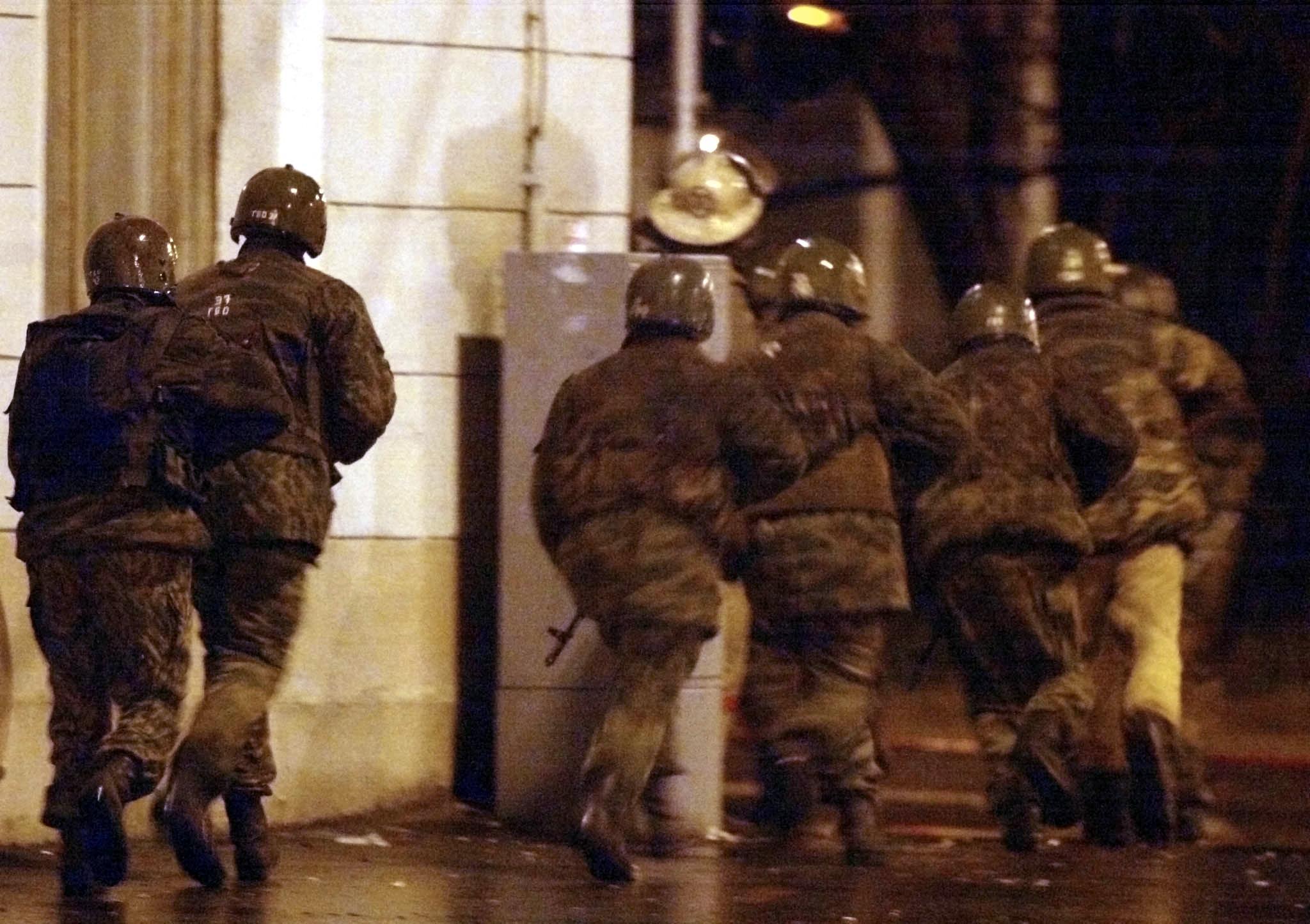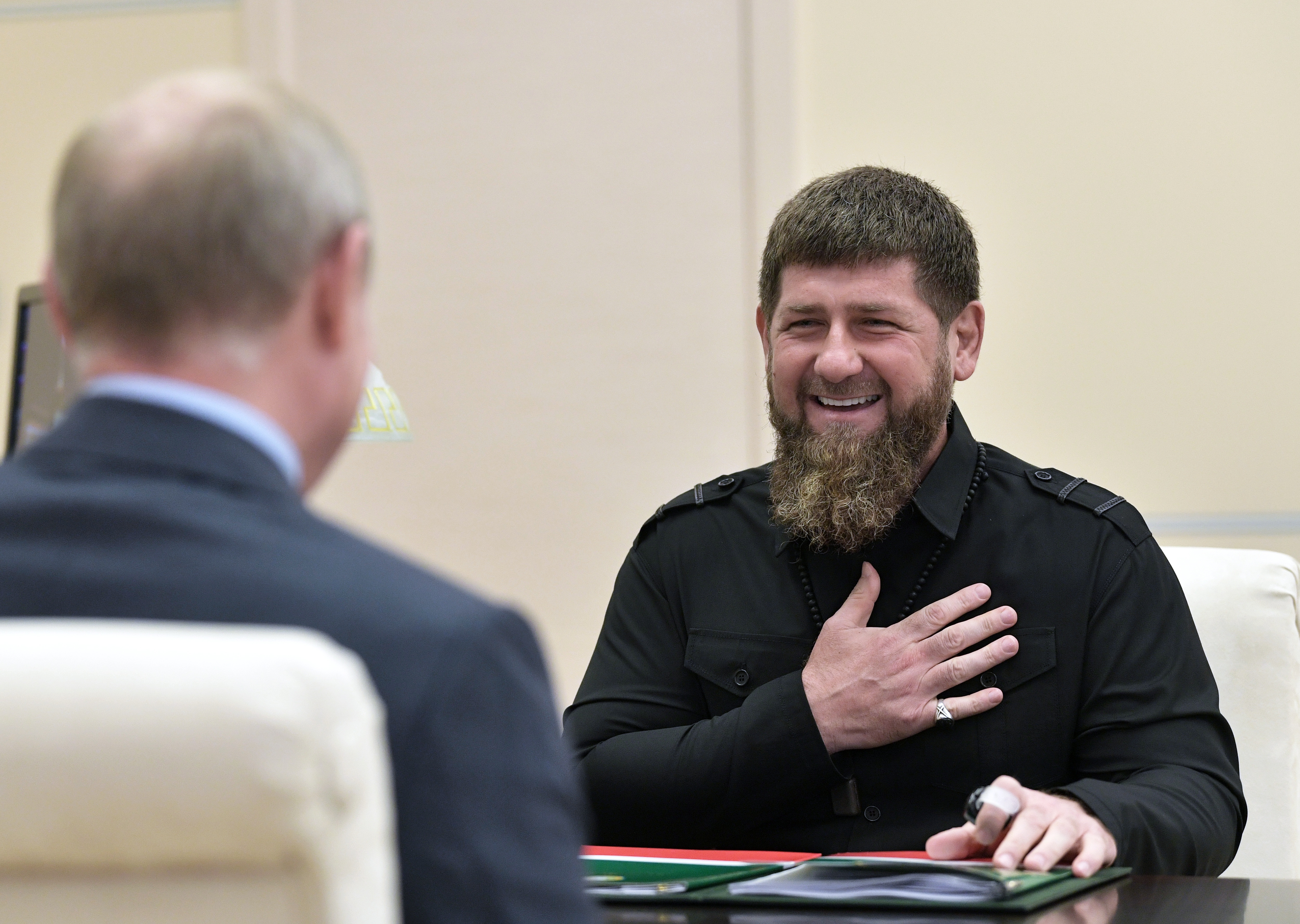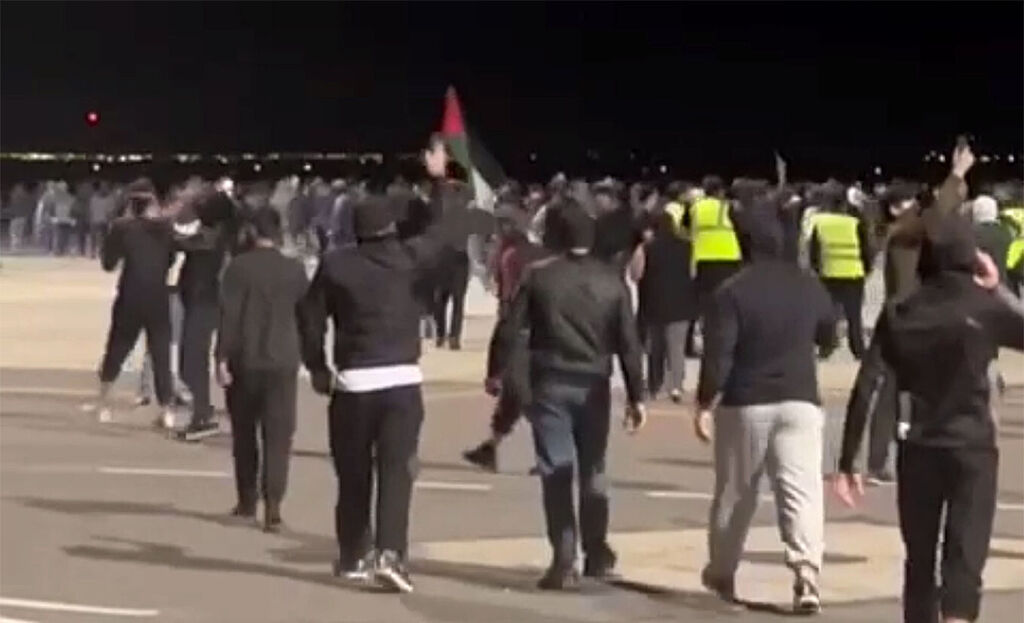After the collapse of the Soviet Union, it took two bloody Chechen wars to pacify the North Caucasus. Recent turmoil shows that cracks begin to reappear in this unstable region. In addition to the precarious economic conditions in the region, the war in Ukraine has stirred new aspirations of independence and caused anger because of disproportionate mobilization of men from the North Caucasus. The Kremlin should start to worry, says region expert Leonardo Zanatta.
 New members of the pro-Ukrainian Dzhokhar Dudayev Chechen volunteer battalion take part in a training session in the Kyiv region on August 27, 2022. Photo: Genya Savilov / AFP/ ANP
New members of the pro-Ukrainian Dzhokhar Dudayev Chechen volunteer battalion take part in a training session in the Kyiv region on August 27, 2022. Photo: Genya Savilov / AFP/ ANP
by Leonardo Zanatta
Since Russia's full-scale invasion of Ukraine began, the leaders of the North Caucasus republics have ardently backed Russian president Vladimir Putin's military efforts. In March 2022, Chechen leader Ramzan Kadyrov announced the mobilization of over 70,000 soldiers (although the actual number deployed to Ukraine was likely only a few thousand). By June of the same year, he had also contributed to the establishment of four battalions of volunteers ('North', 'South', 'West', and 'East' Akhmat). In the following months, battalions were formed in the republics of Dagestan ('Kaspi') and North Ossetia ('Storm-Ossetia' and 'Alania').
At the same time, many North Caucasians have fought on the side of Kyiv, viewing the conflict as a chance to defeat Moscow and reclaim their homeland’s independence. Chechen fighters, in particular, have been a persistent presence in Ukraine, with the initial volunteers arriving shortly after Moscow annexed Crimea and supported the pro-Russian insurgency in Donetsk and Luhansk in 2014.
Their numbers have grown exponentially since February 2022, especially after Kyiv officially recognized Kadyrov’s government as an occupying force in the Caucasian republic. As of today, pro-Ukraine Chechen 'Dzhokhar Dudayev', 'Shaykh Mansur', 'Imam Shamil', and 'Muslim Corps Kavkaz' battalions are fighting against the Kremlin.
The growing involvement of volunteer battalions from the North Caucasus fighting alongside Ukraine represents only one of the several challenges to Russia's authority over a region with a long history of resisting its rule. Hence, after providing historical context on Moscow’s engagement in the North Caucasus, this article examines these challenges and evaluates whether the Kremlin’s strategy for stabilizing its southern frontier remains effective.
A dark chapter in Russia’s history
In 1864, the Russian Empire subdued the North Caucasus, defeating the coalition of local tribes led by Imam Shamil and concluding the longest-running military conflict in its history. Renowned personalities of that period, including Mikhail Lermontov, Lev Tolstoy, and Aleksandr Pushkin, chronicled the conquest of these territories, portraying its violence and ferocity. Since then, the region has been the theater of some of the darkest chapters in Russia’s history.
Between 1943 and 1944, the Soviet government forcibly deported the Karachai, Chechen, Ingush, and Balkar peoples to Central Asia, falsely accusing them of collaboration with Nazi Germany. In more recent history, the North Caucasus region experienced renewed political turmoil. After the collapse of the Soviet Union, the Chechen independence movement led by Dzhokhar Dudayev seized the opportunity to establish the 'Republic of Ichkeria'. Although Dudayev was killed by a Russian strike in 1996, Chechens successfully defended their de facto sovereignty during the first war with Moscow (1994-1996). After a peace treaty signed in 1997, a second war (1999-2009) erupted following Chechen fighters’ infiltration in neighboring Dagestan.
At this point, ethno-nationalist aspirations in Chechnya evolved into a jihadist insurgency. Initially overshadowed by strong nationalist sentiment, religion gained prominence as mujahideen from Muslim countries and Dagestan began promoting militant Islam. Additionally, the inability of local warlords to secure Western support led them to seek funding from Islamic organizations. This combination of factors contributed to the rise of salafism, despite it not being a characteristic feature of Chechen traditional culture.
 In 2002 the Dubrovka Theater in Moscow was captured by Chechen terrorists. Photo: Alexander Nemenov / AFP / ANP
In 2002 the Dubrovka Theater in Moscow was captured by Chechen terrorists. Photo: Alexander Nemenov / AFP / ANP
Extremist violence spilled into neighboring republics and the rest of Russia, resulting in frequent small-scale attacks and sporadic major violence. Notable incidents included the 1999 bombings in North Ossetia, Dagestan, and Moscow. In 2000, a suicide truck bomb in Argun, Chechnya, killed numerous Russian servicemen. The Moscow theater attack in 2002 saw Chechen rebels taking hundreds of hostages. However, the deadliest episode was the 2004 Beslan school siege in North Ossetia, which claimed 344 lives, including over 100 children.
Empowering local warlords
Vladimir Putin's rise to power was characterized by the implementation of the 'Chechenization' policy. This involved delegating authority to loyal warlords, like the Kadyrov family, to maintain stability and reduce terrorist activities. Akhmad Kadyrov was a prominent figure in the resistance against Russia and served as the Chief Mufti of Ichkeria. However, he decided to switch sides during the Second Russo-Chechen War, aligning with Moscow. In the meantime, he had established his personal army, the 'Kadyrovtsy', and entrusted its leadership to his son, Ramzan.
In 2000, the Russian president appointed Akhmad Kadyrov to lead the newly established Chechen Republic as part of the Russian Federation. He maintained the leadership of Chechnya until 2004, when he was assassinated in a bomb attack in the republic’s capital, Grozny.
Following Akhmad Kadyrov’s death, the Kremlin appointed Ramzan as the head of the republic in 2007 and tasked him with quelling the ongoing insurgency. The new Chechen leader continued his father's political course, consolidating power through reprisals and repressions of the salafi communities. He also granted amnesty to former warlords who joined the Kadyrovtsy and pledged loyalty to Moscow. In return, he received generous subsidies and autonomy from the Kremlin, far exceeding that granted to other Russian republics. In the end, the Kadyrovs enabled the Russian president to defeat Chechen separatists in the war and force the Ichkeria government into exile.
 After two bloody wars Putin nominated Ramzan Kadyrov as leader of Chechnya. He restored order with cruel repression. Photo: Aleksey Nikolskyi / EPA / ANP
After two bloody wars Putin nominated Ramzan Kadyrov as leader of Chechnya. He restored order with cruel repression. Photo: Aleksey Nikolskyi / EPA / ANP
Kremlin's counter-terrorism strategy
The later years of the Second Russo-Chechen War saw the emergence of an organization called 'Imarat Kavkaz' (Caucasus Emirate). In 2007, the fifth president of Ichkeria, Dokka Umarov, decided to abandon that post and pursue his vision of an Islamic state, inspired by an entity that existed in Dagestan and the mountainous regions of Chechnya from 1828 to 1859.
From then until 2011, the Caucasus Emirate was responsible for the most atrocious attacks in the region. Notable incidents include the suicide bombing at the police headquarters in Nazran, Ingushetia in August 2009, attacks targeting police officers in Kizlyar, Dagestan, Stavropol and Vladikavkaz in 2010. In September 2011, another suicide bombing struck the Republic’s Ministry of Interior in Makhachkala.
Therefore, the Kremlin decided to launch a counter-terrorism strategy aimed at stabilizing the North Caucasus in a twofold way. Firstly, by iniatiating programs aimed at bolstering socio-economic development in the region. In 2010, president Dmitry Medvedev issued decree No. 82, establishing the North Caucasus Federal District as a separate entity from the Southern Federal District, which hosted the Sochi 2014 Winter Olympics. This decree also paved the way to the 'Strategy of Socioeconomic Development of the North Caucasus Federal District until 2025', designed to address economic issues and improve living conditions in the region.
Again in 2010, Vladimir Putin, who had temporarily stepped back to the post of prime minister, signed decree No. 833, creating a tourism cluster in the North Caucasus Federal District, Krasnodar Krai, and the Republic of Adygea. This goal was only partly successful because the substantial federal subsidies flowing into the region were mainly used for social services rather than economic development. For instance, despite the declared aim to reduce unemployment to around 5%, the rates in 2019 were still high: 13.4% in Chechnya, 13% in Dagestan, and 11% in Kabardino-Balkaria. Secondly, by conducting a counter-insurgency campaign to eliminate most leaders of the Caucasus Emirate and repress salafist practices in the region.
Since then, Russia's southern frontier has witnessed a steady decline in attacks. Between 2010 and 2014, when the group ceased to have a visible presence in the region, attacks attributed to the Caucasus Emirate decreased from 583 in 2010 to 546 in 2011, 465 in 2012, and 439 in 2013.
The shortcomings of this strategy
Despite the Kremlin’s repeated assertions that Chechen separatism and later jihadi terrorism had been eradicated, violence has never fully abandoned the North Caucasus. With the rise of the Islamic State (IS) from the ashes of the Iraqi and Syrian civil wars in 2014, many individuals from the region decided to join the Caliphate forces. In 2015, an audio recording posted on YouTube announced that militants from Dagestan, Chechnya, Ingushetia, and Kabardino-Balkaria had pledged allegiance to IS.
There are several reasons why this happened. Firstly, the possibility offered to these people to live in a Sunni-controlled region governed by a strict interpretation of Islamic law without the danger of being persecuted for that. Secondly, social networks and online propaganda platforms, such as the Russian-language magazine 'Istok', proved to be highly effective in encouraging young generations to join IS. Finally, despite the initiation of the programs mentioned above, since 2017 economic conditions in the North Caucasus have further worsened due to reductions in federal subsidies.
Another challenge derives from the fact that Kadyrov’s powerful position in Russian politics represents a double-edged sword for the Kremlin. First, Moscow’s strategy to curb separatism in the North Caucasus has heavily relied on empowering his leadership. This over-dependence could have serious repercussions if Kadyrov sees his autonomy and power diminishing.
Second, although Kadyrov's methods for combating violent extremism might seem effective, the abuses of human rights carried out by his personal militia have the potential to further increase among locals. This is the case of the so-called 'collective responsibility' policy, where the Chechen government holds the families and relatives of insurgents accountable, and abuses by security forces are reportedly frequent but remain unpunished.
Finally, Kadyrov sometimes appears to be pursuing his own political agenda. Since Russia’s invasion of Ukraine began, the Chechen leader has positioned himself as a central figure in the Kremlin’s war propaganda, portraying his soldiers as invincible and reliable warriors (despite several instances where this has proven untrue). However, some analysts argue that his real goal has been to target his pro-Ukraine opponents abroad.
This strategy has both turned Kyiv into a symbolic battleground in the broader struggle against Russian imperialism and influenced the consolidation of movements advocating for self-determination in Russia. Since the start of the war, the 'Dagestan National Centre' and the 'Galgay Komitet' have become leading advocates for the secession of Dagestan and Ingushetia.
Resurgence in violence
Moscow’s full-scale invasion of Ukraine has also revealed other critical issues that threaten the stability of the North Caucasus. Since September 2022, when partial mobilization started in Russia, protests, both peaceful and violent, have erupted in Dagestan and Kabardino-Balkaria. This was mainly due to the disproportionate contribution of North Caucasian republics in supplying recruits compared to other regions. For instance, in 2024, while Moscow and Saint Petersburg each lost 571 and 551 people respectively in the war, North Ossetia lost 518. Given its smaller population, the Caucasian republic’s per capita death rate was significantly higher—about eight times more than St. Petersburg's and seventeen times more than Moscow's.
As of March 2024, Putin’s war has resulted in the deaths of approximately 300 Chechens, 70 Ingush, 900 Dagestanis, 120 people from Karachay-Cherkessia, and 130 from Kabardino-Balkaria.
The region has also witnessed a resurgence in violence. Last October, anti-Israeli riots took place at Makhachkala airport, and anti-terrorist operations were conducted by security forces in Ingushetia, Kabardino-Balkaria, and Karachay-Cherkessia. Moreover, in June, inmates identifying as Islamic State fighters took hostages in a pre-trial detention center in Rostov-on-Don. Although not located in the Caucasus, this city serves as Russia's main gateway to the region.
 After 7 October Dagestani stormed a plane from Israel at the airport of Makhachkala. Photo: Ekho Dagestana
After 7 October Dagestani stormed a plane from Israel at the airport of Makhachkala. Photo: Ekho Dagestana
On June 23, a series of coordinated attacks shook Dagestan. Assailants set fire to a church and synagogue in Derbent, targeted another church and a traffic police post in Makhachkala—the republic’s capital—and engaged in gunfire with a second police post in the village of Sergokala. A few weeks later, Russian security forces thwarted a similar attack on an Orthodox church in Maykop, Adygea. This series of events has drawn attention to whether Russia is capable of maintaining stability on its southern frontier, especially amidst its intensified focus on the war in Ukraine.
Troubled center-periphery relationship
The North Caucasus holds a significant place in Russia’s tumultuous history. The relationship between Moscow and its southern frontier is marked by a long record of repression and violence. The local peoples’ struggle against the Kremlin has at times been driven by national identity motives and at other times has taken the form of a jihadist war.
Besides transnational terrorism's grip on the North Caucasus, Russia's full-scale invasion of Ukraine has created new challenges for the Kremlin, including the rising number of North Caucasians fighting for its enemy and the emergence of separatist movements within its borders. It has also exposed Moscow’s over-reliance on Kadyrov and how this can have serious implications for the stability of the region. The problem with these new challenges is that they are particularly destabilizing for Moscow because they have the potential to reignite existing tensions.
The recent protests against partial mobilization and the new episodes of violence in the region underscore how Russia has yet to acknowledge its past mistakes. Using regional governors to repress extremism and recruit new soldiers without addressing the injustices characterizing this troubled center-periphery relationship does not appear as a sustainable long-term solution. Putin has managed to suppress the widespread violence of the 2000s, but this recent surge should not be underestimated.
Leonardo Zanatta is a Ph.D. candidate in International Relations at Corvinus University of Budapest and an Associate Research Fellow at the OSCE Academy in Bishkek. He frequently publishes on Russia's policies in the North and South Caucasus.
